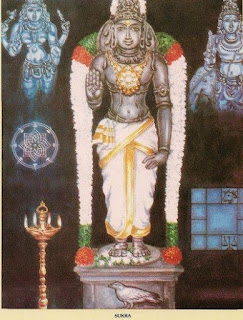Thaipusam
Thaipusam is a festival to celebrate two important events in Hindu history. The first is the anniversary when Lord Murugan received the Vel (spear) from His Mother, Goddess Parvathi. The second event is the day that God Shiva danced the ananda tandava and revealed His form of Nataraja to the devas, sages and priests gathered at the hallowed Shiva temple of Chidambaram in Tamilnadu. Thus Thaipusam is celebrated in both Sivan and Murugan temples, though Thaipusam is more popular as a Murugan festival. Thaipusam is a one-day festival that usually falls in January or the beginning of February.
The Vel(spear) that Lord Murugan received from his Mother is a symbol of purification. According to the myth, the Vel was given to Lord Murugan to vanquish three asuras that were terrorizing Earth and the Heavens at the time. The asuras were Surapadman, Singamugan and Tarakasura. The three of them represent the forces of fear, hatred, greed and arrogance. The Vel, a symbol of light and wisdom was used by Lord Murugan to rid the world of the three asuras and bring peace and balance back to the Heavens and Earth. Thus the Vel is the protecting and purifying force of Lord Murugan and Thaipusam is a celebration of these forces. It is a time to beseech Lord Murugan’s blessing to lessen the burden of bad karmas from our wrongdoings and to make our lives more positive. Thus the Thaipusam is a festival that is marked by acts of penance such as carrying the kavadi.
Carrying kavadi is a practice of penance or prayaschittam. The tradition of carrying kavadi was started by a great devotee of Lord Muruga, Idumban, who worshipped Lord Murugan at the Palani Hills temple in Tamilnadu. He created the first kavadi. It was a simple structure that consisted of a straight horizontal branch of a tree with two small pots of milk tied at either end and decorated by a wooden arch, flowers and peacock’s tail feathers. Idumban also pierced a small vel shaped skewer across his cheeks. Idumban carried the kavadi from the foothills of Palani to Lord Murugan’s Palani Andavan temple at the summit of the hills and offered the milk for Lord Palani’s (the form of Lord Murugan as a renunciate monk) abishekh.
Since those ancient times, the forms of kavadi have become more elaborate. During Thaipusam these days devotees can be seen carrying kavadis as simple as a pot of milk balanced on their heads to elaborate structures rising up to two meters above the head with multiple body piercings. Devotees carrying kavadi usually wear yellow garments. Yellow colour symbolizes purification.
Devotees participating in Thaipusam, especially if they are carrying kavadi, prepare for the festival anywhere between one month to nine days before the festival. These preparations can include:
• Performing daily prayers at home to Lord Murugan,
Carrying kavadi is a practice of penance or prayaschittam. The tradition of carrying kavadi was started by a great devotee of Lord Muruga, Idumban, who worshipped Lord Murugan at the Palani Hills temple in Tamilnadu. He created the first kavadi. It was a simple structure that consisted of a straight horizontal branch of a tree with two small pots of milk tied at either end and decorated by a wooden arch, flowers and peacock’s tail feathers. Idumban also pierced a small vel shaped skewer across his cheeks. Idumban carried the kavadi from the foothills of Palani to Lord Murugan’s Palani Andavan temple at the summit of the hills and offered the milk for Lord Palani’s (the form of Lord Murugan as a renunciate monk) abishekh.
Since those ancient times, the forms of kavadi have become more elaborate. During Thaipusam these days devotees can be seen carrying kavadis as simple as a pot of milk balanced on their heads to elaborate structures rising up to two meters above the head with multiple body piercings. Devotees carrying kavadi usually wear yellow garments. Yellow colour symbolizes purification.
Devotees participating in Thaipusam, especially if they are carrying kavadi, prepare for the festival anywhere between one month to nine days before the festival. These preparations can include:
• Performing daily prayers at home to Lord Murugan,
• Chanting devotional hymns such as the Skanda Puranam or doing japa on Lord Murugan's mantra Aum Saravanabhavaya Namaha (the mantra is chanted 108 times daily after prayers on a rosary of rudraksha beads),
• Fast or abstain from non vegetarian food,
• Not cut their hair nor shave and abstain from carnal pleasures.
• Sleep on the floor (without a mattress).
Men who carry kavadi usually shave their heads bald on Thaipusam day. The type and severity of the kavadi carried and the preparations before Thaipusam the devotee does is left the devotee. Apart from pure devotional motivation, the preparations done and the type of kavadi carried may depend on the severity of guilt or troubles the devotee may be feeling or going through. If unsure of what type of preparations to perform or kavadi to carry a devotee can seek the counsel of a qualified temple priest or a Hindu guru.
Men who carry kavadi usually shave their heads bald on Thaipusam day. The type and severity of the kavadi carried and the preparations before Thaipusam the devotee does is left the devotee. Apart from pure devotional motivation, the preparations done and the type of kavadi carried may depend on the severity of guilt or troubles the devotee may be feeling or going through. If unsure of what type of preparations to perform or kavadi to carry a devotee can seek the counsel of a qualified temple priest or a Hindu guru.



Comments
Post a Comment